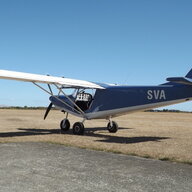Skippy, I used a very fine sewing needle, then tapered it by hand, then inserted it in the (slightly recessed) aluminium 'jet', marking the place with my thumbnail, then extracted it and used vernier callipers.
Easy to write, but in practise not so easy to be confident of an exact measurement. Which is why I wrote 0.38 - 0.4mm
I have remeasured a number of times now, I would say it is around the lower figure.
( But I do know it is bigger than 0.35mm, as I have a wire of that size, and it fits with some additional wiggle room.)
If so, then your current jet at 0.5mm is 42% larger in cross section than mine.
And if the recommended jet size is 0.35mm, your current jet is over twice that size.
So, yes, I agree that the next step is to source and fit a 0.35mm jet.
To answer your question: mine is not a jet, as such. It comes as part of the ICP Savannah kit and is a fuel coupling or spigot, with the end blanked (probably not fully drilled out) and the hole drilled in the end. Possibly manufactured in house.
If you get really stuck, I can send you one, though you would need to figure out thread size and how to mount it.
However, it would probably be easier and also better to source a genuine 0.35mm jet, if you can.
As you say, reducing the jet size may well sort your problem. If not THEN might be a time to check whether it is poor pressure or a poor reading.





